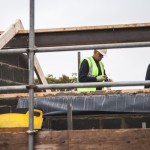The number of new build homes started or completed in England between April and June 2020 fell to their lowest levels since the year 2000 as Covid-19 hit the construction industry, according to new figures.
The figures also show, despite Covid, a longer-term decline in housing starts and completions, with the number of homes started or completed in the year to June 2020 also showing a sharp fall.
According to the Ministry of Housing, Communities and Local Government, the indicators of new housing supply figures should be regarded as a leading indicator of overall supply.
They show:
- The number of dwellings where building work has started on site was 15,930 in April to June 2020 – a 52% decrease when compared to the last quarter. It also follows a recent trend of a slowdown in growth with six of the last six quarters showing a decrease. Starts are 67% below their March quarter 2007 peak and are 7% below the previous trough in the March quarter of 2009. It is the lowest quarterly starts figure in the seasonally adjusted time series (which begins in the year 2000).
- There were 121,630 estimated new build dwellings starts in the year to June 2020, a 26 per cent decrease compared to the year to June 2019.
- The number of dwellings completed on site was 15,390 in April to June 2020. This is a 62% decrease compared to the last quarter and 64% below their level in the same quarter a year ago. Completions are now 67% below their peak in the March quarter 2007 and 37% below the previous trough in March quarter 2013. It is the lowest quarterly completions figure in the seasonally adjusted time series (which begins in the year 2000).
- An estimated 147,180 new build dwellings were completed in the year to June 2020, a decrease of 15 per cent compared to the year to June 2019.
Clive Docwra, managing director of property and construction consultancy McBains said: “Today’s statistics bear out the huge impact that Covid-19 – and in particular the Spring lockdown – has had on housebuilding rates.
“The government target of building a million new homes in the new five years was always going to be a steep challenge, but the pandemic has dealt a heavy blow to that ambition.
“The industry is now facing a double-whammy – trying to recover from the impact of Covid but also suffering from the uncertainty over a Brexit deal – with investors holding off putting money into new developments until the picture on a withdrawal agreement becomes clearer.
“The Government will no doubt point to its recent planning White Paper as the answer to building more homes, saying that it will mean‘permission in principle’ will be given to developments on land designated for renewal to speed-up building, but the uncertainty and resulting fluctuating values driven by Covid and Brexit are reducing the incentive on developers to build in the short term.
“The government could address this by temporarily staggering or deferring Section 106 planning obligations – where developers are asked to provide contributions for community infrastructure – so that developers are encouraged to complete housebuilding projects as soon as possible.”









